Top Product Development Trends to Watch in 2025
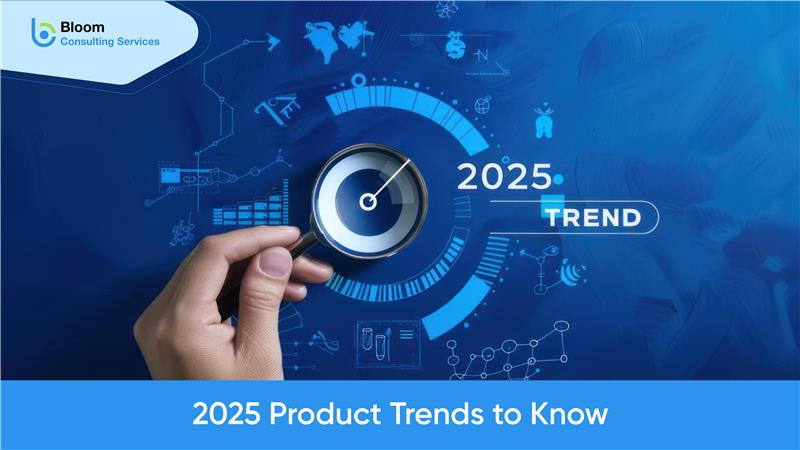
In today’s interconnected world, product innovation is no longer discretionary- it’s a demand of the business world. Stepping forward into 2025, there is a rapid alteration of the product development landscape. From the shifting consumer demand to greater personalization and faster digital disruption, companies have to rethink how they consider, design, and implement their products. Old-fashioned approaches are fading in favor of agile, intelligent, and tech-enabled interaction mechanisms focusing on speed, flexibility, and customer-oriented points of view.
While AI, digital twin, and low-code platform technologies are rewriting engagement protocols, design and development cycles are shortening and getting more competitive. Sustainability is turning into a demand rather than just an ask. Against such a backdrop, keeping a tab on product development trends is vital for any organization that wishes to stay competitive and current.
This blog discusses some of the key trends shaping product development in 2025. It’ll describe the rise of various trends such as automation, generative design, the evolution of cross-functional teams, and cloud-first collaboration through the innovations, methodologies, and mindsets that are transforming how products are envisioned and delivered. From startups to enterprises to outsourced development support, getting your head around these shifts will help you anticipate what comes next and seize the lead from there.
Table of Contents
The Rise of AI in Product Development
As we go beyond the year 2025 into deeper realms of time, artificial intelligence in product development services becomes one of the most exciting transformative forces in the industry. From ideation to user satisfaction, AI is transforming companies to build, test, and launch products in ways unimaginable before.
This is an underpinning force rather than a subtle one, making one of the hottest product development trends a robust adoption of AI for the whole product construction life cycle.
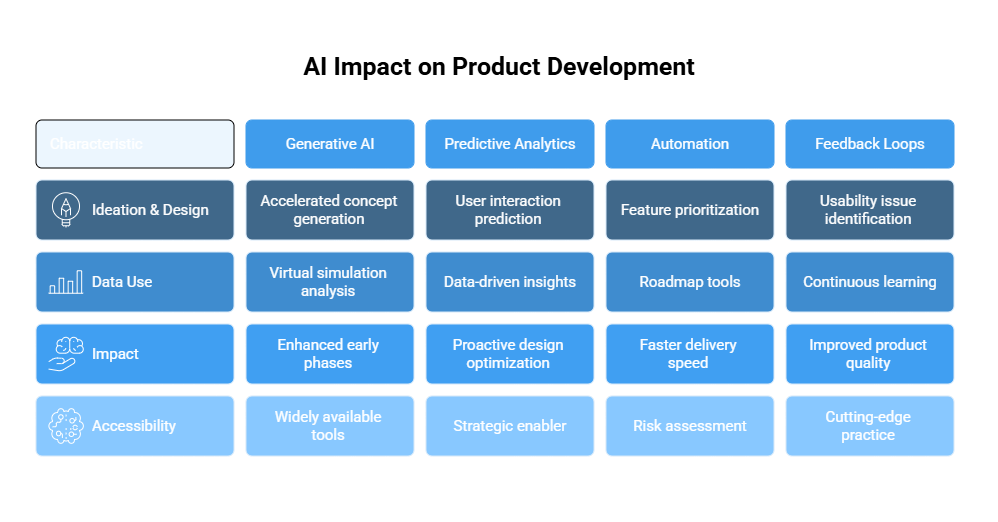
Generative AI: Reimagining Ideation and Design
Generative AI has accelerated and enhanced the earlier phases of product development. Instead of sketching each idea manually, teams enter design parameters- error in material, cost, performance objectives, aesthetic judgment, etc.- into a system that generates intelligent, feasible product concepts by the hundreds in just a few seconds.
A designer can hit the ground running by analyzing the virtual simulation that serves as a reliable indication of actual performance after the creation stage and prior to the physical build of a real prototype. This is a paradigmatic shift in how creativity pairs with computation and one of the landmark product development trends of the digital era.
Turning Data into Insight with Predictive Analytics
Being an almost fatal attraction lies in the ability to extract differences and similarities between vast amounts of data. Forecasts developed through predictive analytics inform in predicting product interactions from the user side: which option will please the users and where they would meet friction.
Considering the discovery of user behavior, AI aids the teams in proactive design optimization, failure reduction, and enhancement of long-term performance. These data-based solutions are the key enablements to the development of better products and wiser resource allocations and are the driving product development trends in competitive markets.
Product Development AI: A Strategic Enabler
What made AI in product development services so distinctive is the element of automation. Enhancement of human decision-making processes, feature prioritization by teams, trade-off consideration, and alignment of product goals to market needs- each could be done with proper AI support.
Intelligent roadmap tools, backlog prioritization, and risk assessment are now part and parcel of daily workflows in development. In some way or another, in the times of AI, guessing has become redundant, allowing teams to deliver at lightning-fast speed without necessarily lowering their standards.
More innovative Feedback Loops and Continuous Learning
Product teams collect feedback and translate it into the user perspective. AI also transformed the methods used by product teams. Where modern tools were deployed, surveys would broadly cover all bases for analysis for such things as support tickets, reviews, and social media sentiment for countless hours of the day. That gives them the edge in identifying usability issues, trends, or potential product hazards at an early stage, even sometimes before the customers have reported them.
The results? A feedback loop that learns, adapts, and enhances itself. It is the spirit of cutting-edge product development trends, especially in fast-moving industries.
From Disruption to Standard Practice
AI is not large-enterprise-size anymore. Increasing cloud-based AI tools allow intelligence to bind itself into the processes even downstream of startups and mid-sized companies. Such democratization sustains lateral communication and works to foster innovation in every sector.
With AI at their behest to scale automatic and personal iterations, building products is very slowly becoming more and more of the defining trend of the year 2025.
Start Your Product Development Journey
Digital Twins Are Going Mainstream
In 2025, digital twins will come into the spotlight as companies look for more innovative ways to design, test, and optimize products. Because these virtual clones of physical products or systems are simulated in real-time and monitored, they have bridged the gap between physical and digital innovation.
This evolution is not something really far-fetched or theoretical but an implementation that works for the respective company and is commercially viable. One of the most promising product development trends this year is the mainstream adoption of digital twins in different industries, from automotive and manufacturing to healthcare and consumer tech.
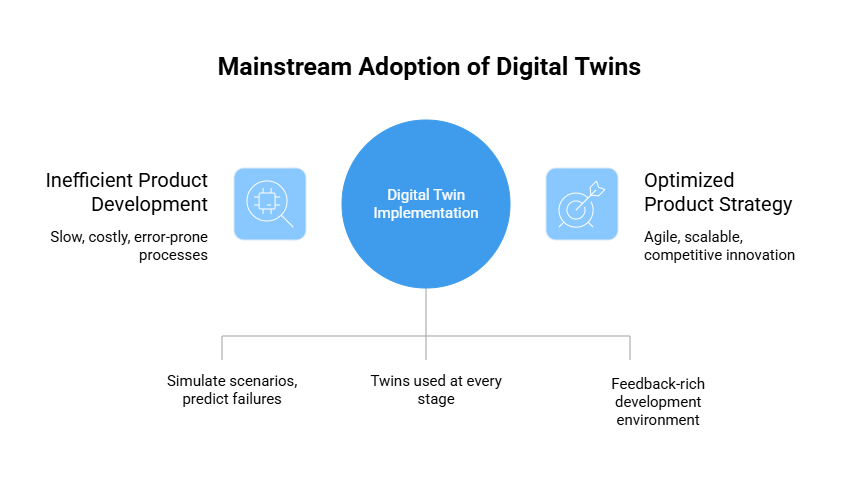
What Are Digital Twins?
Such types of digital twins can be described as dynamic digital models reflecting the behavior, performance, and status of real-world products and systems as they change over time. Sensor data come into the picture to update the digital twins in real-time so manufacturers can simulate usage scenarios or predict failures and validation tests for specific design changes before they can ever be implemented. Because of the increasing demand for customization and ensuring operational reliability, the industry now depends on these twins to verify that what is supposed to excel in the virtual realm will indeed excel physically. Hence, these powers illustrate some major digital twin trends influencing engineering and product strategy in 2025.
Applications Across the Product Lifecycle
Now, digital twins are present at almost every stage of the product lifecycle, from conception to decommissioning. They are used during design to test several variants without wasting material. In production, they assess equipment efficiency and identify impending failures. After the product is launched, they begin to track actual user behavior and environmental performance.
By bridging the gap between digital insight and real-world outcomes so seamlessly, iterations are accelerated, costs rendered lower, and a better product-market fit ensues. It is a prime instance of how product development trends are transitioning toward the continuous improvement axis rather than linear delivery.
Advances in Digital Twin Technology
Now, when viewed through the lens of the present, the technological advancements put in place for digital twins ensure that it is never so advanced as to be out of the reach of every day or so expensive as to be restricted to a few elite cash-holding corporations. The advent of cloud computing, IoT integration, and AI represent newer fronts through which building a robust digital double of one’s product is even possible for the little guy. These systems are, therefore, no longer the forte of just aerospace or heavy manufacturing; they are beginning to permeate consumer electronics, wearables, and smart home appliances alike.
By constantly feeding into a feedback-rich development environment, digital twins troubleshoot issues long before they become really troublesome in the actual world. In short, not only do digital twins serve to shorten the development cycle but also contribute significantly to product reliability, another ongoing theme in the product development trends of 2025.
Driving Strategic Value in 2025 and Beyond
More adoption of digital twins marks this as the predictive data-driven version of product strategy. The business is no longer working on assumptions. It has gone into simulation and testing, and it is iterating in these controlled environments before it is put in the actual environment. This added foresight has only made it better to compete and innovate, thereby lessening avoidable, rank-costing mistakes.
With companies considering options for agility and scalability, digital twins have emerged as a very compelling pitch that sits perfectly well with today’s fast-moving product development trends.
The Evolution of Product Design Thinking
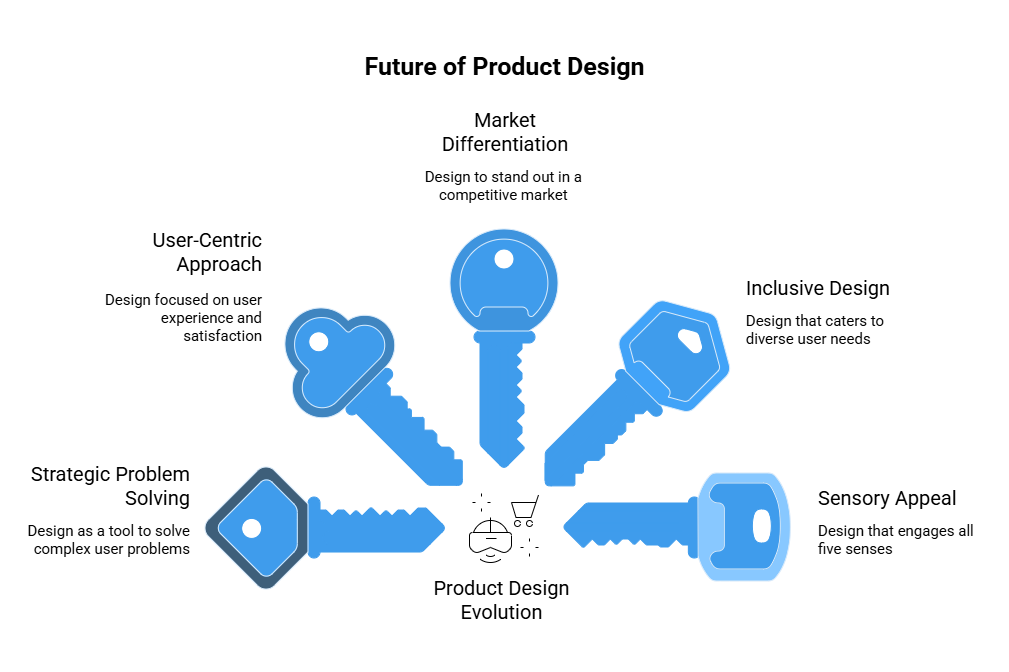
Design is no longer only about aesthetics. By 2025, product design will become a strategic tool for determining how a product solves problems, serves the user, and stands out in an increasingly crowded market. As user expectations shift to encompass ever more complex relations, design thinking itself is becoming more inclusive, immersive, and intelligent.
Such changes relate to product development trends, which emphasize empathy, agility, and rapid experimentation from pre-launch to post-launch. Today, design teams not only come up with a creative vision but apply this alongside data insights to forge products that appeal to all five senses and are prepared for the future.
Inclusive, Human-Centered Design
One of the most defining changes in contemporary design language is the ever-increasing focus on accessibility and inclusiveness. Design teams now consider the needs of diverse user profiles, including age, abilities, culture, and geographies, to make sure that literally anyone can use their products. Design for inclusion becomes a factoring agent during the ideation and prototyping stages rather than as an afterthought in compliance.
This human-first approach will be one of the most crucial product trends for companies that want to create lasting customer trust in 2025.
Let’s Build Your Product from Start to Success
What is Shaping the Product Design Trends in 2025?
The thrust of sustainability and modularity exempts the imagination for product development and consumption behind the labels. Discarding disposable design, the companies would then uphold durability, reparability, and excuses for environments within the brainstorming process.
Those far-sighted priorities stand at the pinnacle of product design trends 2025, especially within consumer electronics, fashion, and mobility.
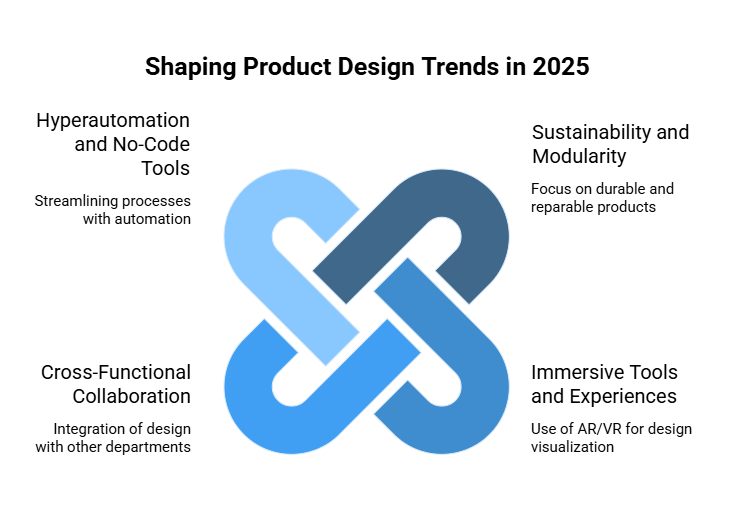
Immersive Tools and Experiences for Design
AR/VR and 3D modeling tools are becoming a standard in design. They can shift how product experiences get visualized, tested, iterated, and even evaluated for ergonomics. Stakeholders can walk through virtual prototypes, assess ergonomics, make instant changes before production, and experience a super-collaborative atmosphere where feedback flows freely, and design errors are spotted early on.
Such workflows are working their way through pockets of excellence and already stand as an antithesis of static wireframes that have been dominant in product design trends.
Design Serves as a Cross-Functional Driver
Modern product design teams do not work in isolation anymore. Designers interact with engineers, marketers, data scientists, and user researchers to synchronously align creative thinking to business and technical goals. This integrated setting promotes a coherent and rich UX along the entire channel and set of touchpoints. These collaborative spirits will break the silos and make possible faster and smarter innovation deliveries and be one of the dominant product developments in 2025.
Design thinking is changing from a creative skill model into a cross-discipline superpower. With technology, data, and user needs converging more and more, companies that choose design as a core strategy instead of just a cosmetic layer will be better equipped to lead in the next innovation wave.
Hyperautomation and No-Code Tools: Powering the Next Wave of Innovation
Automation and related technologies are wreaking havoc on the 2025-age-old product development field as organizations try to deliver faster with fewer resources. The proliferation of hyper-automation and no-code platforms in 2025 is seeing all activities, from ideation all the way down to deployment, getting streamlined so that teams can work faster, with accuracy and agility.
The transformation does not single-handedly benefit large enterprises. Even lean startups are leveraging tools to lower their time-to-market and scale iteration. Hence, with automation-type workflows becoming a leading trend in product development for 2025, the overall goal is to remove menial activities and maximize human creativity.
Hyperautomation Defined
Hyperautomation is the strategic use of advanced technologies such as robotics for process automation (RPA), AI, machine learning, and analytics to automate complex business and development processes. Unlike traditional automation, which manages individual tasks, hyperautomation orchestrates entire workflows.
This means development areas like automatic code generation, QA testing, release pipelines, and customer feedback turn into hyperautomated areas. With this, teams can push updates very frequently with fewer bugs and more confidence.
This expanded automation realm—with continuous delivery as its underlying culture where change is not just expected but embraced—is now reshaping product development trends.
The Emergence of No-Code and Low-Code Solutions
No-code and low-code solutions are speeding up innovation. These platforms allow product owners, designers, and any other concerned stakeholders to create working prototypes, dashboards, or even full-fledged applications via drag-and-drop interfaces without the need for any coding.
This leads to increased early-stage testing and less reliance on engineering resources. This is critical in today’s cutthroat setting, where speed is a distinguishing characteristic. Hence, non-code tools are being picked up in various departments, enabling cross-functional collaboration and faster decision-making.
This also feeds the growth of modern product development technologies that are lightweight, scalable, and geared toward rapid experimentation.
Why It Will Matter in 2025?
Hyperautomation and no-code endeavors are not about driving efficiencies; they now allow support for innovation across all strata of a company. Teams are able to put an MVP out quicker, iterate more, and integrate feedback from the user base in real-time. The final result is a lightweight, stretchy product development approach that is agile and aligns with customers.
Looking at the view of any company wanting to stay relevant in an ever-fastly evolving market, this represents an edge to really leverage. Intelligent automation is becoming a must-have competence that sets the company apart, as found in this year’s product development trends.
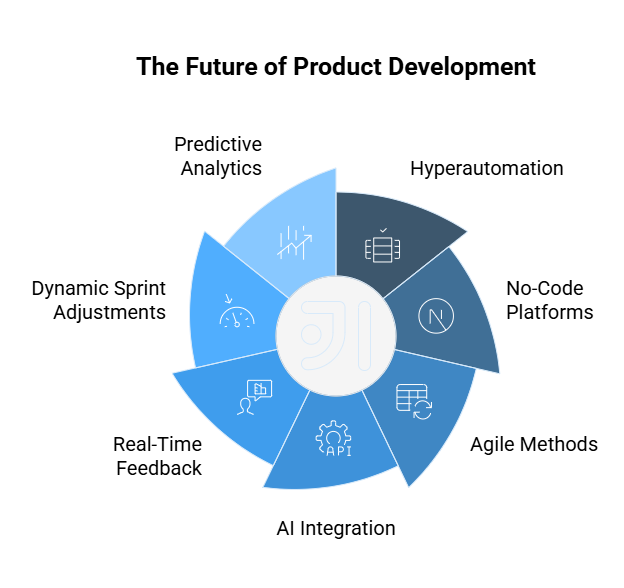
Agile Meets AI: The New Product Development Process
In 2025, agility alone will no longer suffice. With rapidly changing markets and user expectations of instantaneous solutions, companies are now taking Agile workflows to a whole new level through artificial intelligence. This potent synergy is redefining how products are conceived, tested, and delivered, heralding a new age of intelligent and adaptive development.
Agile methods and intelligent automation are converging, or so an increasingly important trend will witness product development in 2023. This, in turn, will empower businesses to respond more appropriately and more confidently to change.
Sprint Planning to Smart Execution
In Agile development, rapid iteration is favored, but many times sprint planning is left largely to human judgment. The AI tools are now filling this vacuum by analyzing user behavior, feature adoption, project velocity, etc. These insights provide better focus to teams to prioritize backlogs, estimate effort values accurately, and reduce delays.
Intelligent automation implements dynamic sprint adjustments based on live user data, so if teams do need to pivot, doing so will not throw off the whole roadmap. This AI-agile melding is at the heart of emerging product development trends, placing intelligence at every stage of the workflow.
Enhancing Product Development
Today, rigid linear models are gone. Instead, product development is a cycle: adaptive and highly integrated. AI supports this by enabling automation in the process of product development such as code reviews, testing, deployment, and bug triage.
For example, AI-driven QA tools detect anomalies quicker than any human tester, thereby decreasing post-release problems. Those predictive analytics tools are also there to spot risky features before going live. The cycle of constant improvements they support ensures products hit the market faster and remain stable.
Reimagining New Product Development with Cloud and Data
In 2025, cloud computing and data analytics will no longer be mere infrastructure choices; these will be strategic enablers of faster and wiser innovations. Companies are now rethinking how they conceive, build, and optimize products using scalable cloud platforms and real-time data streams. At the core of the most significant product development trends, this revolution allows teams to create products at a global scale, provide seamless teamwork, and ensure decision-making is insight-based versus based on guesswork.
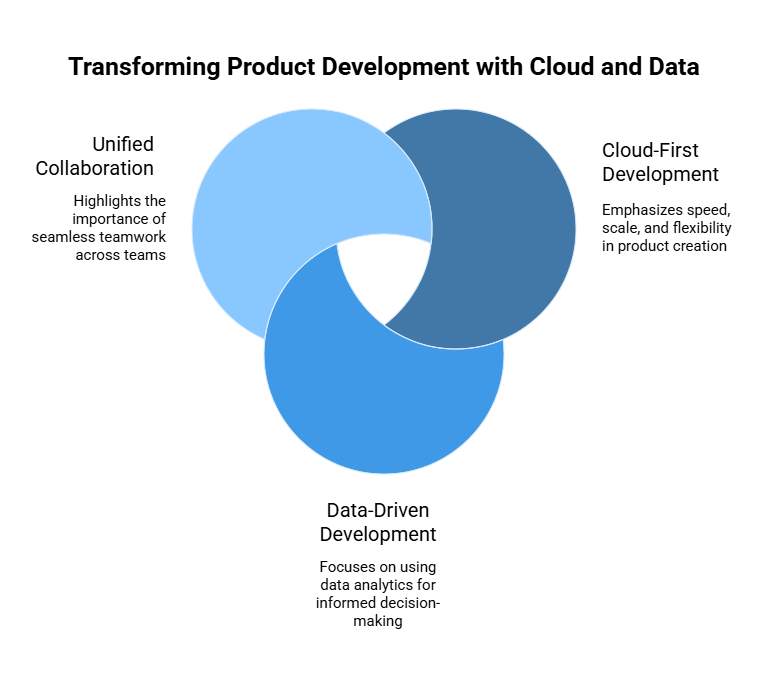
Cloud-First Development: Speed, Scale, and Flexibility
Cloud provides the agility to iterate fast, release often, and test with precision. With shared environments and on-demand resources, teams can create and scale products without that traditional burden of infrastructure.
Cloud-native development, in turn, allows continuous integration and continuous delivery into the heart of the build-and-release system. Developers can launch new features rapidly and with confidence, which aligns very well with today’s product development trends that emphasize responsiveness and time-to-market.
New Product Development in the Data-Driven Era
Within this landscape, New Product Development is being changed. Teams no longer rely on intuition alone to identify opportunities or canvass roadmaps; they employ predictive analytics, user telemetry, and behavioral insights to ascertain market needs and how users behave with products.
The data work organizations do to test these assumptions and validate ideas reduces the risk of failed launches. This evidence-based approach is far removed from the older notions of development, reinforcing the somewhat bold notion that data drives modern innovation.
Turning Insights into Competitive Advantage
Today, companies embed analytics into every stage of development. From early user research to post-launch engagement metrics, data dictates decision-making in feature prioritization, UI/UX improvements, and performance optimization.
Real-time dashboards and AI-enabled reporting help teams immediately detect anomalies, test hypotheses, and adapt. The rapid learning cycle is the essence of the most impactful product development trends of 2025, allowing continuous feedback loops that nurture more innovative, more user-centric products.
The Power of Unified Collaboration
On top of that, the cloud is killing geography and time zones, leading to easier remote cross-functional collaboration than ever before. Design, development, QA, and product management teams can all work on shared platforms in real time, with their decisions unfolding much quicker and breaking down organizational silos.
This collaborative setup endorses fast iterations, makes visibility crystal clear, and paves the road toward equally agreed outcomes. This is yet another big reason why cloud-enabled strategies are at the forefront of current product development trends, especially for global companies looking to expand without adding complexity.
Product Development and Design Teams of the Future
The advent of technology and changes in business models translate to an alteration in the teams that are building the next generation of products. Nowadays, product teams are being transformed into something more collaborative, cross-functional, and highly strategic in terms of structure, skill sets, and culture.
One very human-product-development trend of 2025 is the upgrade of the teams themselves: how they are formed, work together, and foster large-scale innovation.
Cross-Functional Collaboration on the Rise
No more siloed roles paired with strict handoffs. Today, product teams consist of a wide variety of disciplines, including product managers, UX designers, engineers, data analysts, and marketers, all working in close coordination from ideation to launch.
This cross-functional approach emphasizes that in every product decision, business goals, user experience, and technical feasibility must be considered. It is towards this working paradigm that the current product development trends are set, emphasizing speed, alignment, and adaptability.
Product Development and Design as One Strategic Function
Integrating product development and design is becoming the rule rather than the exception. Instead of working as two separate units, both teams now work as one unit responsible for innovation, usability, and product-market fit.
Designers are brought into sprint teams to help write user stories, validate hypotheses, and fine-tune features in real time. This tight integration speeds up feedback and keeps user needs at the forefront during product development.
New Roles for a New Era
The shift that is occurring in product innovation also gives rise to new hybrid roles. Today, we have UX researchers who also know analytics, developers who understand design systems, and product managers who work with AI tools and automation. These hybrid roles are indicative of the increasing value placed on agility, creative thinking, and data aptitude.
In 2025, this is one of the most significant cultural product development trends: the move away from fixed job descriptions and toward fluid, outcome-centered skill sets.
Remote-First, Global-Ready
The shift to remote and hybrid work is another significant factor shaping team structures. Product development is now global by default, and teams work together across time zones in digital workspaces. This has dramatically increased talent availability and promoted inclusiveness in hiring.
Collaboration tools, asynchronous workflows, and cloud-based development environments have placed these distributed teams on par, if not ahead, of their colocated cousins when it comes to speed. A model that supports agility while embracing diversity of thought and diversity of perspective.
Choosing the Right Partners and Tools
Above everything else, a product’s actualization or demise hinges upon whom you build it with. Selecting the right partners and platforms in 2025 is not merely a tactical choice; it has become a strategic decision that can either make or break speed, scalability, and market success.
The pragmatic leaning toward ecosystem thinking in product development is birthed with the advent of specialized tooling and worldwide collaboration. Companies are increasingly forsaking the notion of doing everything on their own as they build strategic relationships that generate measurable value.
| Category | Insight | Brief Explanation |
| Core Idea | Partners determine success | Your product’s fate depends more on who you build with than what you build. |
| Ecosystem Thinking | Collaboration > self-reliance | Companies now rely on global partners and specialized tools instead of building everything in-house. |
| Strategic Focus | Long-term thinking wins | Smart partnerships lead to faster delivery, lower costs, and sustainable growth. |
| Choosing Companies | Look beyond credentials | Pick partners who understand your vision, domain, and complement your team. |
| What Great Partners Do | Go beyond coding | They offer strategy, UX input, scalable architecture, and agile collaboration. |
| Role of Tools | Tools must fit workflows | Misaligned tools slow progress. Choose those that boost speed and collaboration. |
| Ideal Tech Stack | Right mix > latest tools | Teams prefer tools that are secure, flexible, and integrate easily. |
| Tool Trends 2025 | Focus on productivity | Trends favor automation, low friction, cost-efficiency, and real-time collaboration. |
| Long-Term Fit | Think ahead | Choose platforms and partners that grow with your product and evolve with your vision. |
| Competitive Edge | Build for the future | Scalable systems and aligned partners enable faster innovation and lasting success. |
Choosing Product Development Companies
Picking product development companies is more than mere checking of their credentials. It is finding the kind of company that shares your product vision with you, knows your market, and has the skill set that enhances your organization’s skills.
Top-tier partners do not only merely write code. They engage in strategy, share UX knowledge, and provide architecture that can scale. They will integrate into your agile workflow, use the tools you prefer, and work toward common goals with you and your organization from the long term viewpoint and not merely towards short-term project deliverables.
This level of tight collaboration is one of the most prioritized product development trends for companies that want to innovate sustainably and efficiently.
Tools That Contribute to Speed and Agility
Tools rely on the right partnerships; therefore, if not, it will become a development roadblock. From cloud infra and CI/CD pipelines down to design collaboration platforms and AI-assisted coding tools, modern-day teams depend on a tech stack that provides for continuous delivery and iteration.
The “latest” in terms of toolsets is not what people seek in 2025; instead, it is the right mix, one that is lightweight, secure, and plays well with the systems already in place. Nowadays, automation, transparency, and quick decision-making have to be legitimate features of the tools, not just afterthoughts.
Increasingly, these directions are dictated by the larger product development trends, which put a heavy emphasis on flexibility, cost-efficiency, and developer productivity.
Strategic Fit/Long-Term Thinking Setup
When considering tools or partners, long-term alignment is crucial. How does this platform scale with your product growth? Does this partner evolve with your vision? Do they operate in your domain? These guiding questions move the business forward with sustainable development rather than toward short-term convenience.
Organizations that invest in scalable systems and future-ready partnerships gain a competitive advantage. They are not really building a product; they are building the opportunities for future innovations to happen fast and be differentiated for a long time.
Conclusion
In the year 2025, innovation is no longer confined to solely the product itself; it now spills over into how it is designed, developed, and delivered. We talk of AI-aided ideation, digital twin, no code, and cloud workflows–in the present time, the most progressive companies are embracing any and every method that may be used to give birth to a product. These transforming product development trends set a completely new style for teams to collaborate upon, prioritizing agile delivery with absolute precision.
Would-be quick in response to market changes, intelligent tool-using, and user-embedding in each decision will be the places to be ahead. For startups or enterprises, faster releases in line with these trends will lead to better product-market fit and ultimate scalability.
By investing today in the right talent, tools, and partnerships, you can be set to lead tomorrow. The line into the future is digital, data, and heavily collaborative; those willing to evolve will lead the decade. If you are looking to match the product development trends to stay ahead in the market, you can visit us here
Frequently Asked Questions
1. What are the top product design trends to expect in 2025?
In 2025, product design will take a human-centric, sustainable, and data-driven route. Key trends include the incorporation of AR/VR for immersive prototyping, inclusive design for accessibility, and modular systems that promote product life. These 2025 product design trends show advances toward further personalization, ethical sourcing, and seamless user experience.
2. Why are product development trends important for businesses in 2025?
Understanding product development trends fosters competitiveness by adapting to changing technologies, consumer behaviors, and market dynamics. Trends such as hyper-automation, AI integration, and cross-functional collaboration help companies with faster innovation processes while saving on cost and risk.
3. What are the most impactful product development technologies today?
The technologies in product development at the beginning of 2025 included cloud-based CI/CD pipelines, AI-driven testing tools, digital twin platforms, and low-code/no-code development environments. These technologies enable prototyping at high speed, performing user validation, and setting up deployment strategies for scaling.
4. How is AI being used in product development?
AI in product development is used for generative design, predictive analytics, real-time user feedback analysis, and intelligent planning for roadmaps. It streamlines decision-making and automated testing and helps the teams in delivering more personalized and efficient products.
5. What are the latest digital twin trends in 2025?
These days, digital twin trends revolve around real-time integration with IoT devices or cloud simulation environments, with AI-assisted monitoring. These let companies virtually test their products, predict when maintenance is needed, and improve product performance after launching it in the market.
6. How have product design trends evolved in recent years?
Recent product designing trends have given emphasis to empathy-driven UX, minimalism, and sustainability. Agile, data, and collaboration tools are used these days to design things so that they may look functional but also appeal to one’s emotions and are ethically responsible.



